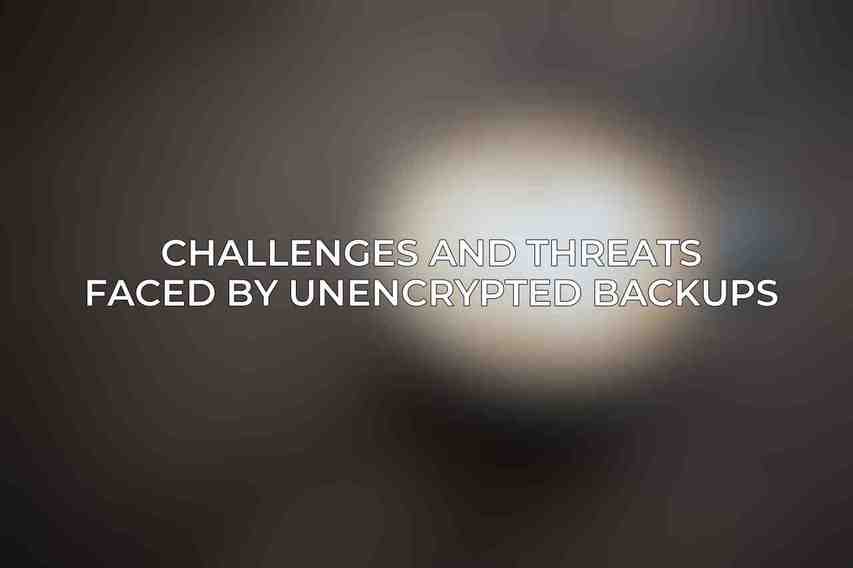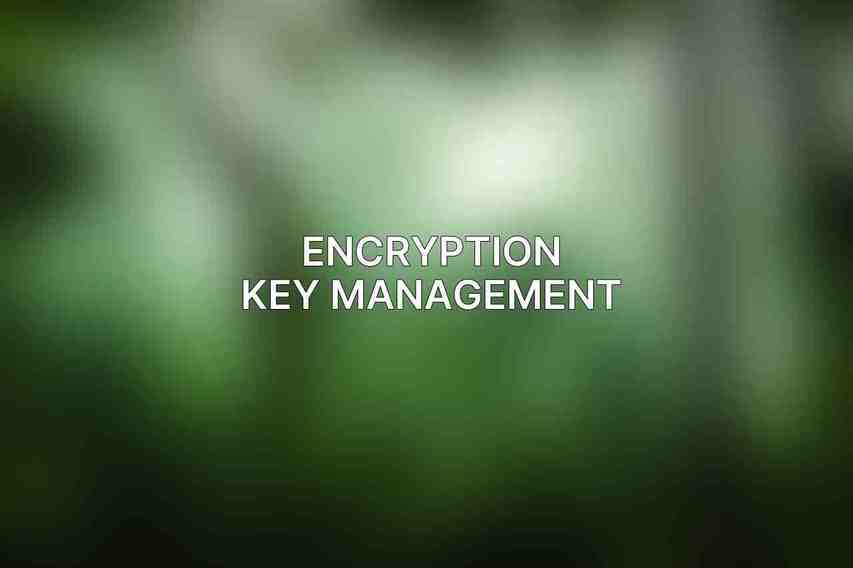Data security is paramount, and ensuring the confidentiality and integrity of backups is crucial for businesses and individuals alike. Backup encryption plays a vital role in safeguarding sensitive information from unauthorized access or breaches. By encrypting backups, data is converted into a secure format that can only be accessed with the corresponding decryption key, providing an additional layer of protection.
Importance of Backup Encryption
Backup encryption helps protect data both at rest and in transit, reducing the risk of data breaches and ensuring compliance with privacy regulations such as GDPR and HIPAA. It secures information stored in backups from being compromised, even if the backup media is lost or stolen.
Challenges and Threats Faced by Unencrypted Backups

Unencrypted backups are vulnerable to unauthorized access, hacking, and data theft. Without encryption, sensitive information can be easily extracted from backup files, exposing individuals and organizations to significant risks such as identity theft, financial loss, and reputational damage.
Encryption Standards for Backup
When it comes to encryption standards for backups, several algorithms offer robust protection for data confidentiality. Let’s explore some of the most commonly used encryption standards:
AES Encryption
Advanced Encryption Standard (AES) is a widely adopted symmetric encryption algorithm known for its security and efficiency.
| Features and Benefits | Key Lengths and Security Levels | AES Encryption Algorithms |
|---|---|---|
| High Security | 128, 192, 256 bits | AES-128, AES-192, AES-256 |
Blowfish Encryption
Blowfish is a fast and secure encryption algorithm suitable for various applications.
| Features and Benefits | Key Lengths and Security Levels | Blowfish Encryption Algorithms |
|---|---|---|
| Fast Encryption | Variable up to 448 bits | Blowfish |
3DES Encryption
Triple Data Encryption Standard (3DES) provides enhanced security through multiple encryption passes.
| Features and Benefits | Key Lengths and Security Levels | 3DES Encryption Algorithms |
|---|---|---|
| Strong Encryption | 112, 168 bits | 3DES |
Twofish Encryption
Twofish is a symmetric key block cipher with a strong track record of security.
| Features and Benefits | Key Lengths and Security Levels | Twofish Encryption Algorithms |
|---|---|---|
| Highly Secure | 128, 192, 256 bits | Twofish |
Serpent Encryption
Serpent encryption is known for its high security and resistance to cryptanalysis. Explore further with Ultimate Guide to Encrypting Your Backups Securely
| Features and Benefits | Key Lengths and Security Levels | Serpent Encryption Algorithms |
|---|---|---|
| Robust Security | 128, 192, 256 bits | Serpent |
Encryption Techniques for Backup
When implementing backup encryption, various techniques can be employed to secure data effectively. Let’s explore some popular encryption techniques:
File-Level Encryption
File-level encryption encrypts individual files and folders, providing granular control over data access.
- Benefits: Allows selective encryption, facilitates sharing of encrypted files.
- Drawbacks: May impact performance due to overhead of encrypting/decrypting files.
- Implementation Platforms: TrueCrypt, VeraCrypt.
Volume-Level Encryption
Volume-level encryption encrypts entire volumes or disks, offering comprehensive protection for all data within the volume.
- Benefits: Efficient for large-scale encryption, ensures all data is secured.
- Drawbacks: Requires additional steps for selective access.
- Implementation Platforms: BitLocker, FileVault.
Cloud-Based Encryption
Cloud-based encryption secures data stored in cloud environments, safeguarding it from unauthorized access.
- Benefits: Enhances cloud security, supports compliance requirements.
- Drawbacks: Dependence on cloud service provider for security.
- Service Providers and Features: Amazon Glacier, Microsoft Azure Blob Storage.
Hardware-Based Encryption
Hardware-based encryption utilizes specialized cryptographic hardware to secure data at the hardware level.
- Benefits: High security, independent of software vulnerabilities.
- Drawbacks: Costlier than software-based encryption.
- Devices and Features: Encrypted USB Drives, NAS Devices with Encryption.
Encryption Key Management

Effective encryption key management is crucial for maintaining the security of encrypted backups. Proper key management ensures that encryption keys are securely generated, stored, and rotated as needed.
Importance of Secure Key Management
Secure key management is essential to prevent unauthorized access to encrypted data. Keys should be kept confidential and protected from loss or theft to maintain the integrity of the encryption system.
Key Generation Methods
Encryption keys can be generated using random algorithms, passphrases, or key derivation functions. Secure key generation practices help create strong encryption keys that are resistant to attacks.
Key Storage Best Practices
Encryption keys must be stored securely, preferably in a dedicated key management system or hardware security module (HSM). Access to keys should be restricted to authorized personnel only. Read more on Top Backup Security Solutions Compared: Find Your Fit
Key Rotation Strategies
Regular key rotation enhances security by replacing existing keys with new ones periodically. Key rotation mitigates the risks associated with long-term key exposure and improves overall encryption resilience.
Best Practices for Backup Encryption
Implementing best practices for backup encryption enhances the overall security posture of an organization and ensures the integrity of backup data.
Use Strong Encryption Standards
Employing robust encryption algorithms with adequate key lengths strengthens the security of backup data and reduces the risk of unauthorized access.
Implement Layered Encryption
Implementing layered encryption by combining different encryption techniques enhances data protection and adds complexity for potential attackers.
Test and Monitor Encryption Systems
Regularly testing encryption systems and monitoring their performance helps identify any vulnerabilities or weaknesses that could compromise data security.
Educate Users on Encryption Policies
Educating users on encryption policies and best practices fosters a culture of security awareness, reducing the likelihood of data breaches due to human error or negligence.
backup encryption is a critical aspect of data security that ensures the confidentiality and integrity of sensitive information. By utilizing the best encryption techniques and implementing secure key management practices, organizations can mitigate risks and safeguard their data against evolving threats. Looking ahead, future trends in backup encryption are likely to focus on advancements in quantum-resistant encryption and the integration of encryption technologies into emerging storage solutions.
By prioritizing backup encryption and leveraging the latest encryption standards, businesses and individuals can strengthen their defenses against data breaches and unauthorized access, ultimately safeguarding their most valuable asset – their data.
Ensure the safety of your data by implementing top backup encryption techniques today! Read more about this on Essential Backup Security Best Practices for Safety
For more information on data encryption and cybersecurity, check out Cybersecurity and Infrastructure Security Agency and Encryption in the Cloud.
Frequently Asked Questions
What is backup encryption?
Backup encryption is the process of converting data into a secure format to prevent unauthorized access during storage or transmission.
Why is backup encryption important for data security?
Backup encryption is important for data security because it protects sensitive information from being accessed by unauthorized parties in case of theft, loss, or breach.
What are some top backup encryption techniques?
Some top backup encryption techniques include AES (Advanced Encryption Standard), RSA (Rivest-Shamir-Adleman), and TwoFish. These techniques ensure secure encryption of data during backups.
How can I implement backup encryption for my data?
You can implement backup encryption by using encryption software or tools that support encryption algorithms. Make sure to choose a strong encryption method and securely manage the encryption keys.
What are the benefits of using backup encryption techniques?
Some benefits of using backup encryption techniques include data confidentiality, integrity, and availability. It helps in complying with data protection regulations and ensures data remains secure.

